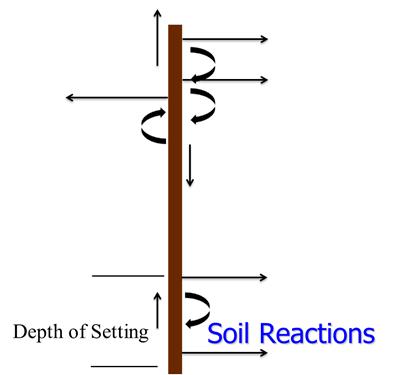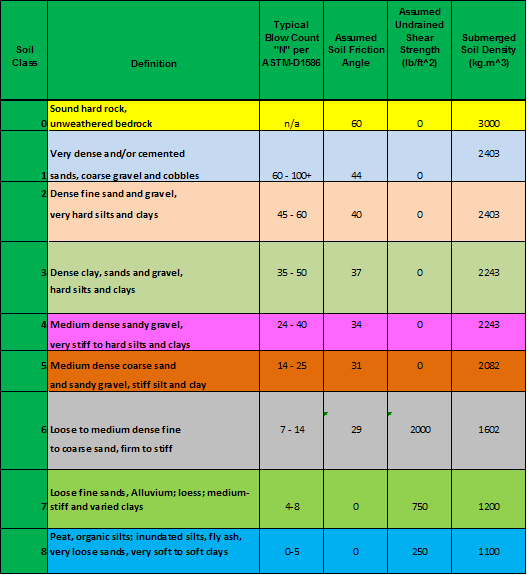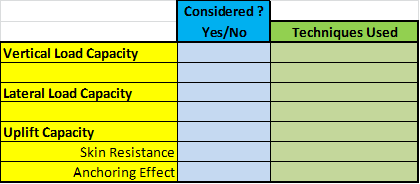Foundation Analysis
This section is used to test the ability of line design software to evaluate the strength of the soil to hold the pole in place. The most common considerations are groundline moments and vertical loads.

The strength of the soil is best described by Soil Class, which is common in the utility industry. It is a general categorization that can be interpreted from most provincial/state/city geological maps with soil descriptions. Since detailed soil analysis providing accurate soil strength parameters is not common for distribution pole lines, this is the most appropriate method.
It is true that the strength of soils is negatively impacted by water saturation. It can be argued that a particular pole may need to support its extreme loads only when soil can be considered dry or unsaturated, when it is stronger. That is left to a Designer's choice. However, for comparison of results from Line Design Software, saturated soil strengths of specific values should be used for all test results. Discussion on whether changes to these values would be appropriate is encouraged in the Industry.
Soil strengths by class:

Foundation Response / Soil Reactions
The following are the major reactions that should be evaluated as part of the Foundation strength requirement:
- Vertical Load Capacity: The soil directly beneath the pole's butt must not fail under Vertical Load.
- Lateral Load Capacity: The soil must hold the pole vertical while it is holding the required amount of lateral forces and moments at the groundline.
- Uplift Capacity: In cases when the pole is subjected to a net upwards vertical force, the soil's ability to restrain the pole must be evaluated.
Each reaction test will be discussed separately so as to describe how these calculations can be performed.
Vertical Load Capacity
Poles can be subjected to large vertical loads under heavy guying conditions. This net vertical force onto the pole can be significant enough to cause the soil to fail. By failure we mean that the soil failed to restrict the pole from moving under the required load. The common definition of soil failure is when the soil "gives" more than 1 inch (25mm).
There are several methodologies and theories available to evaluate this requirement. Most come from evaluation of shallow footings.
Lateral Load Capacity
Particularly for Unguyed poles but for others as well, there can be significant groundline moments and forces required for the soil to support. Since soil as a material has certain properties such as cohesion, shear strength, friction, it is reasonable to expect that strong groundline moments may require deeper setting depths or stronger soil.
Here are the most common approaches to evaluating lateral soil capacity, in order of increasing accuracy:
- Is Depth of Setting equal to or better than 10% of the pole's length plus two feet (0.61m)?
- RUS Bulletin 1724E-200, chapter 12. Tests categorize soils as good, average and poor.
- Effective Stress Analysis methods such as those proposed by Broms and Flemming. Uses soil parameters such as soil friction angle and undrained shear strength.
- P - Y curves approach correlating pole deflections to corresponding soil reactions at all depths.
- Finite Element Solid Material Analysis techniques.
Uplift Capacity
Anyone that has ever seen the stub of a pole being pulled out of the ground by a truck with a boom winch, knows that the truck is going to need to work hard in order to pull it out of the ground. Oftentimes the ground next to the pole stub is loosened first in order to make it possible in the first place.
There are two well know mechanisms that help keep a pole from being lifted out of the ground:
- Skin Resistance: The friction of the soil against the side of the pole below ground level.
- Anchoring Effect: Since most poles are tapered, the difference between the pole's butt diameter and that at groundline serves to help anchor the pole in the ground.
Both of these effects increase along the depth of the pole and vary with soil properties and the depth of the water table.
General Tests for all Line Design Software

Specific Tests if Software Permits
All tests assume a 40ft class 4 WRC pole set to a depth of 6ft(1.828m) in class 4 soil.
Vertical Load.
Starting at 5KN vertical load, increase load and record when soil fails.
Lateral Load.
Starting at 5KN-m groundline moment load, increase load and record when soil fails.
Uplift Capacity.
Starting at 5KN upwards vertical load, increase load and record when soil fails.